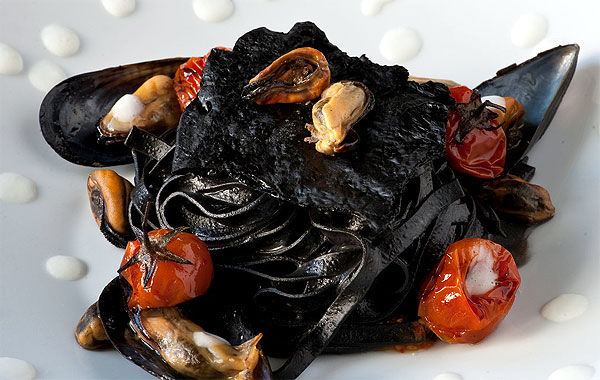Squid Ink: FAQs, Facts, and Know-Hows
Category : Food Stories, Party Ideas, Recipes, Press Room |
Posted : Feb 24, 2020
If you weren’t born in Japan or in the Mediterranean, you know for sure that only dark chocolate, coffee and tea can be black. Even though these foods are actually not black but rather dark brown, everyone’s fine with “black.” We all know it since childhood.
So, should you surrender to your curiosity and try really black pasta or really black risotto? Black foods are both attractive and intimidating. While red color smells and tastes with strawberry, and green color smells and tastes with fresh cucumber, we can hardly associate black color with something edible. Until we find out about squid ink.
 Professional chefs and home gourmets use it as a pungent and natural additive for spaghetti and pasta, rice, sauces, and even burgers. But what makes squid ink so welcome in restaurant and home cooking? Let’s make this out!
Professional chefs and home gourmets use it as a pungent and natural additive for spaghetti and pasta, rice, sauces, and even burgers. But what makes squid ink so welcome in restaurant and home cooking? Let’s make this out!
What is squid ink?
It’s a black liquid pigment that the squid, cuttlefish, octopus, and the like, produce to protect themselves from predators.
Scientists believe that self-defense isn’t the only reason why cephalopods (this is the umbrella term for the mentioned animals) need and release ink. Yet, all the other reasons are waiting to be discovered.
When the squid or cuttlefish feels danger, it releases the ink from the ink sac. The ink gets dispersed in the water, forming a dark cloud which obscures the predator’s view. So, the cephalopod has some time to escape.
Cephalopod ink has dark colors due to melanin, the same compound that gives darker colors to human skin, hair, and eyes. The ink of the squid is rather black-blue, while the cuttlefish ink has a shade of brown.
Mostly, on the market you’ll find jarred cuttlefish ink. It’s considered to have a milder flavor than squid ink. But both products can be legally classified as squid ink, since the squid and the cuttlefish are very close “relatives” in the sea.
Is it poisonous?
No, it isn’t poisonous and can’t do any harm to humans. Unless you are allergic to some nutrients in squid ink, you can enjoy the dish with it without worries.
It’s not the Japanese fugu fish, definitely.
Is food with squid ink just an Instagram trend?
Dishes with squid ink are traditional to Japanese, Italian, and Spanish cuisines. Everything exotic is a casual thing somewhere overseas.
So, if you’re going to throw a Japanese or Italian style party, some black-colored localized specialty will be a great accompaniment for sushi or pizza, respectively.
And if you’re planning a Halloween dinner, some black spaghetti bolognaise is a must-cook on your menu.
Is it healthy?
Doctors and scientists would say that it’s not harmful if you consume it in rational quantities.
Squid ink is rich in iron, copper, iodine, amino acids, and antioxidants. Our bodies do need all of these things. But honest experts will tell you that the really enjoyable amount of ink in your food is too small to have any noticeable positive influence on your health.
If you feel wonderful after eating squid ink risotto, you’d better attribute your wellness to rice and seafood.
How much squid ink will be enough?
Not more than two or three teaspoons for the whole dish, even not for a yield.
If this amount seems too little, let’s remember how much oil or vinegar recipes usually take. Squid ink is a condiment too. A few teaspoons will be enough to change the color and flavor of your dish.
What does it taste and smell like?
Gourmets will say that squid ink tastes and smells with the sea.
To be more precise, the flavor of squid ink is close to the flavor of fresh sea fish with some umami hints.
To remember umami flavor, think of soy sauce or blue cheese.

What to cook with squid ink?
Let’s list these sumptuous options once again:
- Spaghetti with plenty of olive oil and Parmesan. Or with plenty of butternut squash if it’s Halloween.
- Risotto or paella.
- Stuffing for clams casino. Don’t forget to add some white wine.
- Black bread if you are a fan of baking.
- Spooky cocktails. Note that one-two drops will be absolutely enough.
How to remove squid ink from your outfit?
While squid ink in foods won’t stain your teeth, it may stain your new dress or shirt. That’s not nice. But you can fix that quite easily if the stain is fresh.
If your outfit is pure white, opt for some bleach.
- Wet the stain with cold water.
- Dip an ear pick into the bleach and gently sponge the stain until it disappears.
- Wash the clothes in cold water.
If your outfit is of any other color, take the following steps:
- Use a half cup the Oxyclean powder. Add a little boiling water to it, so you can stir it and make a thick paste of it.
- With the wooden spoon, apply a thick layer of the paste onto the stain. If needed, fold an old towel and place it under the stain.
- Leave until the paste starts to dry. Use a wet brush to work the paste into the stain. Then, soak in cool water. Good luck!













